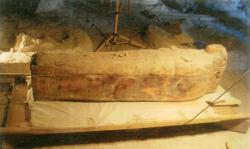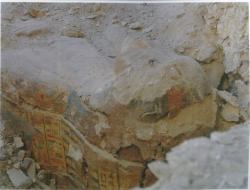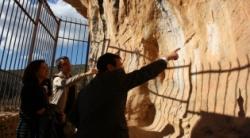INSTITUT SUPERIEUR D'ANTHROPOLOGIE
INSTITUTE OF ANTHROPOLOGY
ONLINE COURSES / COURS A DISTANCE
WINTER TERM : JANUARY 2015
REGISTER NOW
EGYPTE – 
 Assassif - During restoration work at Amenhotep Huy tomb, at Qurnet Marei at Assassif area on Luxor’s west bank, a Spanish Egyptian archaeological mission stumbled upon what is believed to be the sarcophagus of god Amun’s singer. Minister of Antiquities Mamdouh Eldamaty told Ahram Online that the sarcophagus is well preserved condition and houses the mummy of the deceased. He continued that until now the name of the sarcophagus owner has not been revealed yet but the sarcophagus is dated to the Third Intermediate Period (100-900 BC). “It has a unique style that was common during the reign of the 21th dynasty,” Eldamaty told Ahram Online. Abdel Hakim Karrar antiquities director general in Upper Egypt explains that the sarcophagus is carved in wood and covered with plaster decorated with scenes depicting different ancient Egyptian gods, among them Toth, Anubis, Osiris, Isis and the four sons of Horus. Hieroglyphic text is engraved on the sarcophagus, which is currently being studied for information regarding the identity of the deceased. Karrar continued that the mummy of the deceased is found inside the sarcophagus but wrapped with linen and its face is covered with a mask. A religious necklace was found on his chest and a wig decorated with a flower crown on his head.
Assassif - During restoration work at Amenhotep Huy tomb, at Qurnet Marei at Assassif area on Luxor’s west bank, a Spanish Egyptian archaeological mission stumbled upon what is believed to be the sarcophagus of god Amun’s singer. Minister of Antiquities Mamdouh Eldamaty told Ahram Online that the sarcophagus is well preserved condition and houses the mummy of the deceased. He continued that until now the name of the sarcophagus owner has not been revealed yet but the sarcophagus is dated to the Third Intermediate Period (100-900 BC). “It has a unique style that was common during the reign of the 21th dynasty,” Eldamaty told Ahram Online. Abdel Hakim Karrar antiquities director general in Upper Egypt explains that the sarcophagus is carved in wood and covered with plaster decorated with scenes depicting different ancient Egyptian gods, among them Toth, Anubis, Osiris, Isis and the four sons of Horus. Hieroglyphic text is engraved on the sarcophagus, which is currently being studied for information regarding the identity of the deceased. Karrar continued that the mummy of the deceased is found inside the sarcophagus but wrapped with linen and its face is covered with a mask. A religious necklace was found on his chest and a wig decorated with a flower crown on his head.
http://english.ahram.org.eg/NewsContent/9/40/117458/Heritage/Ancient-Egypt/The-sarcophagus-of-god-Amuns-singer-unearthed.aspx
FRANCE – 
 Nîmes - L’Institut National de Recherche Archéologique Préventive a fait une impressionnante découverte lors d’une fouille rue de Saint-Gilles à Nîmes (Gard). En amont de la construction d’un immeuble, un ensemble funéraire couvrant plusieurs siècles a été mis au jour ainsi qu’une voie Antique. Entre le 22 septembre et le 3 novembre dernier, une équipe de sept archéologues de l’INRAP a mis au jour un ensemble funéraire couvrant une période allant du Ier siècle avant notre ère jusqu’au VIème siècle. D’origine préventive et prescrite par l’État, cette fouille a notamment permis la découverte d’une sépulture d’époque wisigothique à Nîmes, une première archéologique. « Que les wisigoths soient passés par Nîmes, nous le savions déjà. En revanche, c’est la toute première fois que l’on identifie une tombe wisigothique du Vème siècle » explique Cécile Martinez de la direction interrégional de l’INRAP. Située rue de Saint-Gilles, les fouilles ont également permis de mettre au jour le tracé de la voie Antique qui reliait Nîmes à Espeyran (ancien nom de Saint-Gilles), ainsi que son embranchement avec une voie secondaire arrivant depuis le sud-ouest. Si l’origine exacte de ces voies n’est pas connue à ce jour, elles remonteraient au moins à l’Antiquité, et ont pu être utilisé pendant plusieurs siècles. Pour Marilyne Bovagne, responsable scientifique de l’opération, l’analyse des données récoltées pourrait mener vers d’autres découvertes. « Cette première attestation d’un cimetière d’époque wisigothique témoigne de leur influence sur la ville de Nîmes pour laquelle on possède très peu d’éléments archéologiques de la période allant du Vème au VIIème siècle. Des analyses pratiquées sur la parure pourraient renseigner sur les tissus portés, des prélèvements sur les ossements pourraient être révélateurs de pratiques alimentaires à Nîmes à cette époque. » Une vingtaine de tombes ont été étudiées, dont les plus anciennes datent de l’époque dite Républicaine (IIème et Ier siècle avant notre ère). Des objets appartenant probablement à un guerrier de la société gauloise ont été découverts soit une épée, une lance et un umbo (partie métallique de bouclier), ainsi qu’une stèle Antique avec une inscription latine mentionnant un gladiateur. La plupart des autres sépultures ont été emménagées au moyen de tuiles plates et courbes, une technique caractéristique de l’Antiquité tardive et du Haut Moyen âge (du IVème au VIeme siècle). La présence de cet ensemble funéraire aux abords d’une voie Antique peut sembler anecdotique à première vue, mais elle témoigne d’une habitude de l’époque. « Cette configuration est connue dans l’Antiquité puisqu’on inhumait ou incinérait aux abords extérieurs des remparts, le long des chemins d’accès, à la vue des vivants pour conserver la tombe dans la mémoire. Pour la période suivante qui voit s’imposer le christianisme, on aurait tendance, quand les conditions le permettent, à regrouper les défunts à proximité des églises. Mais dans le cas présent, nous n’avons pas trouvé d’église dans l’emprise de fouille ».
Nîmes - L’Institut National de Recherche Archéologique Préventive a fait une impressionnante découverte lors d’une fouille rue de Saint-Gilles à Nîmes (Gard). En amont de la construction d’un immeuble, un ensemble funéraire couvrant plusieurs siècles a été mis au jour ainsi qu’une voie Antique. Entre le 22 septembre et le 3 novembre dernier, une équipe de sept archéologues de l’INRAP a mis au jour un ensemble funéraire couvrant une période allant du Ier siècle avant notre ère jusqu’au VIème siècle. D’origine préventive et prescrite par l’État, cette fouille a notamment permis la découverte d’une sépulture d’époque wisigothique à Nîmes, une première archéologique. « Que les wisigoths soient passés par Nîmes, nous le savions déjà. En revanche, c’est la toute première fois que l’on identifie une tombe wisigothique du Vème siècle » explique Cécile Martinez de la direction interrégional de l’INRAP. Située rue de Saint-Gilles, les fouilles ont également permis de mettre au jour le tracé de la voie Antique qui reliait Nîmes à Espeyran (ancien nom de Saint-Gilles), ainsi que son embranchement avec une voie secondaire arrivant depuis le sud-ouest. Si l’origine exacte de ces voies n’est pas connue à ce jour, elles remonteraient au moins à l’Antiquité, et ont pu être utilisé pendant plusieurs siècles. Pour Marilyne Bovagne, responsable scientifique de l’opération, l’analyse des données récoltées pourrait mener vers d’autres découvertes. « Cette première attestation d’un cimetière d’époque wisigothique témoigne de leur influence sur la ville de Nîmes pour laquelle on possède très peu d’éléments archéologiques de la période allant du Vème au VIIème siècle. Des analyses pratiquées sur la parure pourraient renseigner sur les tissus portés, des prélèvements sur les ossements pourraient être révélateurs de pratiques alimentaires à Nîmes à cette époque. » Une vingtaine de tombes ont été étudiées, dont les plus anciennes datent de l’époque dite Républicaine (IIème et Ier siècle avant notre ère). Des objets appartenant probablement à un guerrier de la société gauloise ont été découverts soit une épée, une lance et un umbo (partie métallique de bouclier), ainsi qu’une stèle Antique avec une inscription latine mentionnant un gladiateur. La plupart des autres sépultures ont été emménagées au moyen de tuiles plates et courbes, une technique caractéristique de l’Antiquité tardive et du Haut Moyen âge (du IVème au VIeme siècle). La présence de cet ensemble funéraire aux abords d’une voie Antique peut sembler anecdotique à première vue, mais elle témoigne d’une habitude de l’époque. « Cette configuration est connue dans l’Antiquité puisqu’on inhumait ou incinérait aux abords extérieurs des remparts, le long des chemins d’accès, à la vue des vivants pour conserver la tombe dans la mémoire. Pour la période suivante qui voit s’imposer le christianisme, on aurait tendance, quand les conditions le permettent, à regrouper les défunts à proximité des églises. Mais dans le cas présent, nous n’avons pas trouvé d’église dans l’emprise de fouille ».
http://www.fdesouche.com/542435-nimes-30-impressionnante-decouverte-lors-dune-fouille-archeologique
ROYAUME UNI - Warsop - A group of archaeologists are a step nearer discovering whether 200 buried skeletons will prove an ancient battle took place near Warsop. The Battle of Hatfield Investigation Society (BIOHIS) hopes to rewrite the history of the Battle of Hatfield and relocate the site of the death of Edwin - England’s first Christian king - from Doncaster to Cuckney. The group has spent 18 months trying to resolve the mystery of the skeletons discovered in mass burial pits by subsidence contractors at St. Mary’s Church, Cuckney in 1950/51. Paul Jameson, BIOHIS spokesman, said the group was close to getting a final decision to allow them permission to scan and then excavate the site near the church they believe the skeletons were re-interred. He said: “No artefacts were found to help date the skeletons, but they were said to be the bodies of young men with perfect sets of teeth. “A choirboy of that period remembers “pick type” damage to the 30 or so skulls he saw.” They believe the bodies could be casualties from the 632 AD Saxon Battle of Hatfield, where King Edwin was slain. The word, “Hatfield” has long been associated with the area and so far the society have traced it back to the Domesday book (1086), where it is referred to as, “Cukeney upon Hattefeild”. Additionally, Edwinstowe (meaning Edwin’s Holy or resting place) is only about three miles to the east.
http://www.hucknalldispatch.co.uk/news/local/skeletons-could-be-clues-to-ancient-battle-site-near-warsop-1-6993197
ESPAGNE –  Pinos - Benissa has its own 'Eve'. Just a few centimetres tall, she is outlined in a Stone Age shelter in Pinos and was painted 6,000 years ago. She is depicted standing with her hands on her hips in what archaeologists believe is probably one of the first depictions of a female figure in the Valencia region. The Pinos site contains some of the most important examples of prehistoric art in Alicante province. It was included in the Mediterranean basin’s Rock Art that UNESCO designated World Heritage sites in 1998 and now more paintings have been found during restoration work at the site. Some are geometric motives but there are human figures, too, and 'Eva Pinera' is clearly no longer alone. Drawn in the stylised outlines typical of Levante rock art, the discoveries show a larger person followed by four smaller figures. “They give the impression that they are hand-in-hand,” said Ruben Vidal, the archaeologist in charge of restoring the Pinos shelter.
Pinos - Benissa has its own 'Eve'. Just a few centimetres tall, she is outlined in a Stone Age shelter in Pinos and was painted 6,000 years ago. She is depicted standing with her hands on her hips in what archaeologists believe is probably one of the first depictions of a female figure in the Valencia region. The Pinos site contains some of the most important examples of prehistoric art in Alicante province. It was included in the Mediterranean basin’s Rock Art that UNESCO designated World Heritage sites in 1998 and now more paintings have been found during restoration work at the site. Some are geometric motives but there are human figures, too, and 'Eva Pinera' is clearly no longer alone. Drawn in the stylised outlines typical of Levante rock art, the discoveries show a larger person followed by four smaller figures. “They give the impression that they are hand-in-hand,” said Ruben Vidal, the archaeologist in charge of restoring the Pinos shelter.
https://www.euroweeklynews.com/news/costa-blanca-north/item/124379?